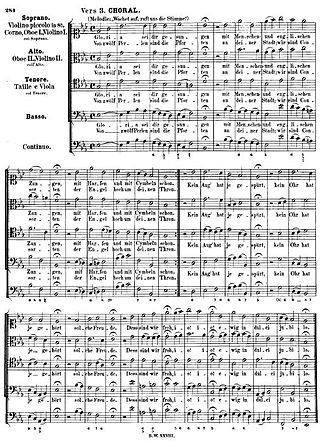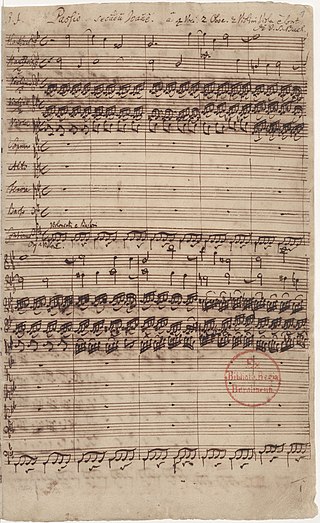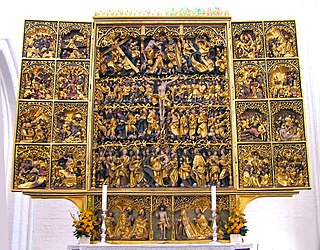Related Research Articles

A Lutheran chorale is a musical setting of a Lutheran hymn, intended to be sung by a congregation in a German Protestant Church service. The typical four-part setting of a chorale, in which the sopranos sing the melody along with three lower voices, is known as a chorale harmonization. The practice of singing in unison was the rule of the reformed churches, both in Germany and in other countries.

The Passio secundum Joannem or St John Passion, BWV 245, is a Passion or oratorio by Johann Sebastian Bach, the earliest of the surviving Passions by Bach. It was written during his first year as director of church music in Leipzig and was first performed on 7 April 1724, at Good Friday Vespers at the St. Nicholas Church.
St Mark Passion refers to the Passion of Christ as told in chapters 14 and 15 of the Gospel of Mark.
The year 1604 in music involved some significant events.

In Christian music, a Passion is a setting of the Passion of Christ. Liturgically, most Passions were intended to be performed as part of church services in the Holy Week.

Between 1716 and 1767, Georg Philipp Telemann wrote a series of Passions, musical compositions reflecting on Christ's Passion – the physical, spiritual and mental suffering of Jesus from the hours prior to his trial through to his crucifixion. The works were written for performance in German churches in the days before Easter. A prolific composer, Telemann wrote over 40 Passions for the churches of Hamburg alone, of which 22 have survived according to the present state of research. He also wrote several Passion oratorios. Unlike the Passions intended for liturgical performance, they were not closely set to the literal text of the Gospels.
St Matthew Passion is a Passion setting composed by Johann Sebastian Bach in 1727 or 1729
Friedrich Nicolaus Bruhns or Brauns was a German composer and music director in Hamburg.
As Thomaskantor, Johann Sebastian Bach provided Passion music for Good Friday services in Leipzig. The extant St Matthew Passion and St John Passion are Passion oratorios composed by Bach.

Jesus Christus ist um unsrer Missetat willen verwundet is a St Mark Passion which originated in the early 18th century and is most often attributed to Reinhard Keiser. It may also have been composed by his father Gottfried or by Friedrich Nicolaus Bruhns. Johann Sebastian Bach produced three performance versions of the Passion, the last of which is a pasticcio with arias from George Frideric Handel's Brockes Passion. There are two other extant 18th-century versions of the Passion, both of them independent of Bach's versions. The Passion was performed in at least three cities in the first half of the 18th century: in Hamburg in 1707 and 1711, in Weimar around 1712, and in Leipzig in 1726 and around 1747.
Joachim von Burck, also Joachim a Burgk or Joachim Moller was a German composer, notable for an early German Passion setting. As Johann Sebastian Bach's predecessor at the church of St Blasius, he pioneered the musical life in post-Reformation Mühlhausen, bringing it to early fruition. Influenced by the tradition of Flemish polyphony and the Italian madrigal, he developed his own style, focusing on clarity of expression. Considering himself a servant to the word of God, he discovered the German language as the foundation of his work, pragmatically addressing the congregation: "for I have aimed to set the words to the music in a manner that almost each syllable has its own note and that the four parts sing the words simultaneously in order that the listener can hear the words clearly." Burck's compositions were widely disseminated and acclaimed for their suitability for common use.

The structure of the St John Passion, BWV 245, a sacred oratorio by Johann Sebastian Bach first performed in Leipzig on Good Friday 1724, is "carefully designed with a great deal of musico-theological intent". Some main aspects of the structure are shown in tables below.
"Jesus Christus, unser Heiland, der von uns den Gotteszorn wandt" is a Lutheran hymn in ten stanzas by Martin Luther for communion, first published in 1524 in the Erfurt Enchiridion. It is one of Luther's hymns which he wrote to strengthen his concepts of reformation. The models for the text and the melody of Luther's hymn existed in early 15th-century Bohemia. The text of the earlier hymn, "Jesus Christus nostra salus", goes back to the late 14th century. That hymn was embedded in a Hussite tradition.
Bartholomäus Gesius was a German theologian, church musician, composer and hymn writer. He worked at Schloss Muskau and in Frankfurt (Oder) and is known for choral Passions in German and Latin and for the melody and first setting of the Easter hymn "Heut triumphieret Gottes Sohn", which was used in several compositions including a cantata by Dieterich Buxtehude and a chorale prelude by Johann Sebastian Bach, concluding the Easter section of his Orgelbüchlein.

"Was mein Gott will, das g'scheh allzeit" is a Lutheran hymn in German. The text from c. 1550 is attributed to Albert, Duke of Prussia. The melody, Zahn No. 7568, goes back to a tune by Claudin de Sermisy, written in 1529 for a secular French song. The hymn has belonged to core Lutheran hymnody without interruption and is part of the Protestant hymnal Evangelisches Gesangbuch as EG 364.

A chorale is the name of several related musical forms originating in the music genre of the Lutheran chorale:

"Ein Lämmlein geht und trägt die Schuld" is a Lutheran Passion hymn in German by Paul Gerhardt. The hymn text was first published in Johann Crüger's Praxis Pietatis Melica, starting from the lost 1647 edition. Wolfgang Dachstein's 16th-century "An Wasserflüssen Babylon" melody is commonly indicated as its hymn tune, although other settings exist.
Anne Bierwirth is a German contralto, focused on concerts and recordings of sacred music, appearing internationally. Besides the standard repertoire such as Bach's Christmas Oratorio, she has explored rarely performed Baroque music such as Bach's St Mark Passion and Reinhard Keiser's Passion oratorio Der blutige und sterbende Christus.
References
- ↑ Etudes - Volume 372 1901 - Page 861 " Histoire de la Passion et de la mort de NS (1594) de Johannes Herold (1550-1603), dont le livret emprunte aux quatre évangiles pour culminer sur les sept paroles de Jésus en croix, et le ... "
- ↑ Howard E. Smither A History of the Oratorio: The oratoria in the baroque ... 0807812943 - 1977 - Page 8 "... of the Passion and Suffering of Our One Redeemer and Savior Jesus Christ," 1594). :1 Other through-composed historiae are those by Joachim a Burck (1568),11 Johann Steurlin (1576), Johann Machold (1593), Johannes Herold (1594), ...
- ↑ Basil Smallman, The Background of Passion Music (1970), p. 143: "fairly frequently in Passion music; yet to the present author's knowledge there is only one surviving instance. This occurs in the six-part St Matthew Passion by Johannes Herold which was composed at Klagenfurt in 1594"